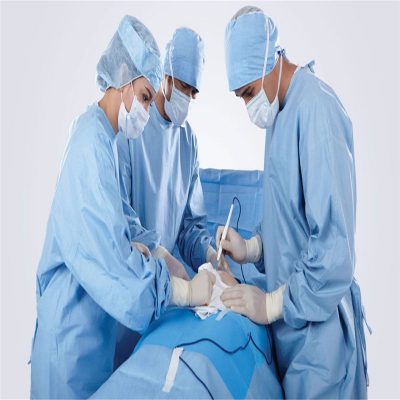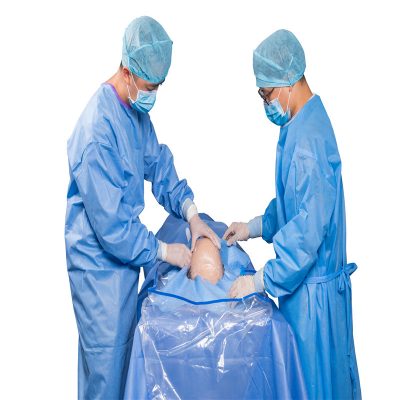The aseptic areas of the surgical staff during the operation are: the chest below the neck and above the waist, hands, forearms, side chest and the back of the surgical gown. The surgical personnel should ensure that these areas are sterile and wear sterile surgical gowns to form a sterile Operate in the area to avoid infection of the surgical site.
(1) Split surgical gown
1. Take the folded sterile surgical gown from the instrument table, choose a more spacious space, hold the collar, shake it open, and make the other end of the gown hang down. Be careful not to make the surgical gown touch other objects or the ground.
2. Hold the two corners of the collar with two hands, and spread the sleeves forward so that the inner side of the clothing faces you.
3. Gently throw the clothes upwards, insert your hands into your sleeves, stretch your arms forward, do not lift your shoulders high, and do not spread it to the left or right to avoid touching the pollution.
4. The roving nurse grabbed the inner face of the collar behind the wearer, assisted in pulling out the cuffs, and tied the back strap of the collar.
5. The dresser crosses his hands, leans forward slightly, uses his fingers to pinch the belt and hands it backwards, and is caught and fastened by the traveling nurse behind. After putting on the surgical gown, your hands should be raised in front of your chest.
(2) All-inclusive surgical gown
1. After washing your hands, take out the surgical gown, lift the collar and shake it open to expose the cuffs.
2. While gently throwing the surgical gown up, stretch your arms and forearms into the sleeves of the sleeves and stretch them forward in parallel.
3. The itinerant nurse ties back straps behind her.
4. Wear sterile gloves.
5. Pass the loose knot of the front waistband to the surgeon or itinerant nurse who has put on gloves. Use sterile forceps to hold the waistband around the wearer for a week, and then hand it over to the wearer and tie it to the waist by himself.























